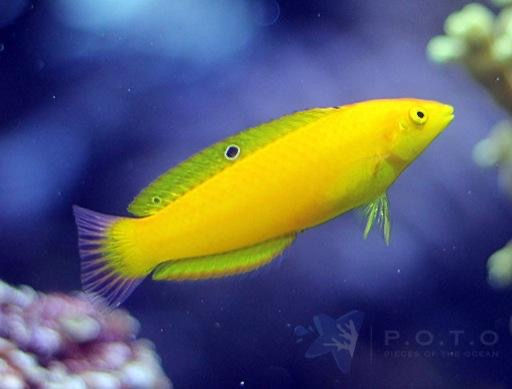Coris Wrasse is a vibrantly-colored wrasse that is sure to add visual appeal and energy to any aquarium in the marine realm. For example Yellow Wrasse is a popular species of wrasse for hobbyists at all levels due to its toughness and small size. It is interesting to note that young and juvenile female Yellow Wrasses have several dark spots along their fins. However, mature adults will have only one spot. The natural distribution for the Yellow Wrasse is concentrated in the Eastern Indian Ocean, extending to the Western Pacific Ocean including the Solomon Islands and north to Southern Japan, and as south as Rowley Shoals and the Australian coast of New South Wales. This Yellow Wrasse is a reef-associated species, usually found along the edges of reefs in rubble and sand areas. The best configuration to house Wrasse will be a properly-established saltwater tank of at least 50 gallons with a lid that is tight. In order to create the best habitat for your Wrasse Aquascape your aquarium with live rock, allowing plenty of places to allow your yellow Wrasse to investigate, search for refuge, or hunt in search of food. Make sure you have an extensive area of open substrate, in addition to open spaces to swim in. A layer of sand about 2 inches deep is necessary to give shelter to the Wrasse while it digs into the sand to enjoy the evening or when scared. Keep the Wrasse along with other tranquil species of wrasses. This includes the species it is a part of. The nutrition of Yellow Worasses is composed of benthic invertebrates . As they are large and hungry, the Wrasse can be found eating pyramidellid snails and fireworms. They are also responsible for safeguarding corals and clams from these harmful invertebrates. While this desire to eat invertebrates is advantageous, remember that Wrasse are unable to distinguish from "undesirable" or "desirable" invertebrates. If an opportunity arises for it, the Yellow Wrasse is most likely to take a bite of "desirable" decorative invertebrates such as shrimp, fan worms, and other crustaceans that are in the aquarium in your home. But it is important to note that the Wrasse is not likely to cause harm to sessile invertebrates, such as soft corals or hard corals. In the aquarium at home, the food plan of the Worm needs to include a variety of food items, such as mysis shrimp, enriched frozen brine shrimp, as well as other meaty food items, high quality marine flakes as well as marine pellet foods. This Yellow Wrasse will appreciate frequent, small-sized feedings all day long.
The Green Wrasse, also known as the Pastel Green Wrasse or Green Coris is a gorgeous fish that has a stunning pastel green hue. Although it doesn't have the intricate designs or intricate markings of other Halichoeres Wrasse species, it is a stunning fish. Green Wrasse injects spectacular visual interest into any marine aquarium due to its vivid green hue. It is a lively fish that spends the majority of its time searching looking for tasty tidbits of food to feast on. The Green Wrasse is frequently praised as a great wrasse in a communal aquarium as it is at ease. However, older specimens tend to exhibit aggression toward smaller, more active fish, including wrasses. The best setup to house the Green Wrasse should be an aquarium with a saltwater tank that has been established for 75 gallons at a minimum with a tight fitting lid. Aquascape with a lot of live rock, offering plenty of spaces that allow your Green Wrasse to investigate, find refuge, or hunt to find food. Make sure you include an extensive area of open substrate and also open areas for swimming. A sandy layer of substrate that is 2-3 inches thick is required to give shelter to the Green Wrasse while it burrows into the sand to spend the evening, or when it is scared. Place the Green Wrasse alongside other tranquil Wrasses, which includes members of the species it is a part of. The nutrition of Green Wrasse is comprised of benthic marine invertebrates. As they are large and hungry, the Green Wrasse consume fireworms and pyramidellid snails. They are also responsible for safeguarding corals and clams from harmful invertebrates. While this desire to eat invertebrates is advantageous, remember it is the case that Green Wrasse is unable to distinguish between "undesirable" or "desirable" invertebrates. If the chance arises for it, the Green Wrasse is likely to take a bite of "desirable" ornamental insects such as shrimp, fan worms, and other crustaceans found in the aquarium at home. But the Green Wrasse will typically not hurt sessile invertebrates like soft or hard corals. The nutrition for the Green Wrasse is to comprise various food items, including mysis shrimp that are vitamin-enriched and frozen as well as vitamin-rich brine shrimp that are frozen, as well as other meaty foods in addition to top-quality marine flakes as well as marine pellet food. This Green Wrasse will benefit from frequent, small-sized meals during the course of the day.
top of page
SKU: 0334
$129.95Price
bottom of page



